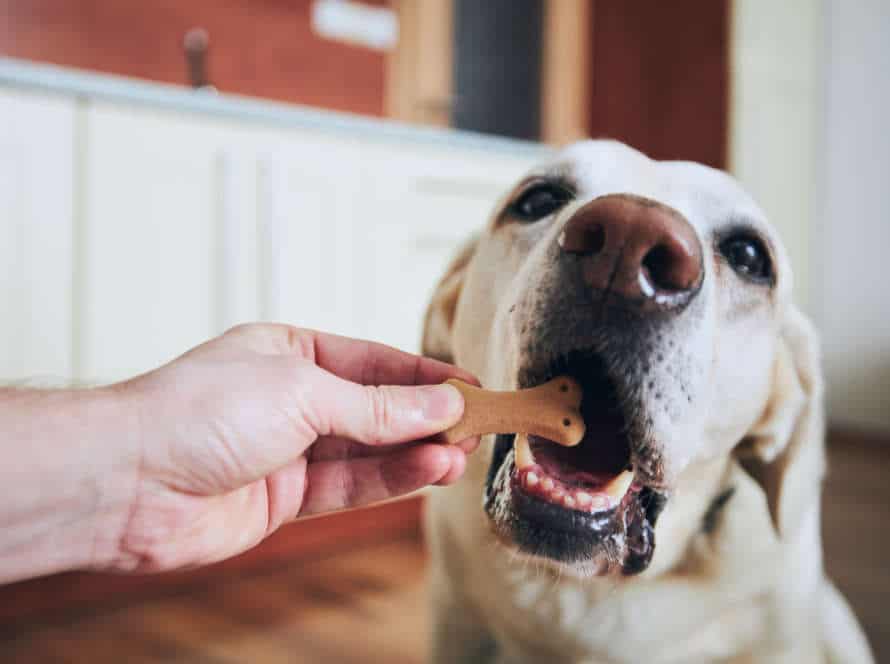How to Choose the Right Dog Food: A Comprehensive Guide
Confused about what food to give your dog? Don’t worry, here is a guide to help you select the best one.
Firstly, take into account your pup’s age, breed and activity level.
Secondly, check the ingredients and make sure the first one is a good source of protein.
Thirdly, pick food that is approved by the AAFCO (Association of American Feed Control Officials).
Fourthly, steer clear of artificial preservatives, colors and flavors.
Fifthly, think about if your dog needs special diets such as grain-free or hypoallergenic.
Lastly, watch the calorie content to prevent overfeeding and obesity.
By keeping these factors in mind, you’ll be able to choose the right food for your pup’s health and happiness.
Understanding Dog Nutrition
Dogs need to eat right, just like us! It’s vital to comprehend the fundamentals of pooch nutrition to guarantee your pup gets the best sustenance and has enough energy to live joyfully. This segment will inspect the various pieces of an appropriate diet for your canine buddy and how to furnish them with essential vitamins and nutrients.
Know your dog’s nutritional requirements
It’s vital to understand your pup’s nutritional requirements. For a healthy, balanced diet that meets all their needs, here are the key nutrients to look for in their dog food:
- Protein: Dogs need a high-quality protein diet like chicken, beef or fish.
- Carbohydrates: Dogs use carbs for energy, but they’re not essential. Opt for whole grains or veggies instead of fillers like wheat or corn.
- Fat: Fat is necessary for absorbing vitamins and energy. Aim for moderate fat content, such as chicken fat or fish oil.
- Vitamins & Minerals: Dog food must contain essential vitamins & minerals like Vitamin A, B vitamins, calcium and iron.
- Probiotics: Good bacteria, or probiotics, are important for digestion. Look for dog food with probiotics like lactobacillus acidophilus.
Pro Tip: Talk to your vet to decide your pup’s nutritional needs based on their breed, age and activity level.
Learn about macronutrients and micronutrients
Macronutrients and micronutrients are key for getting a grip on dog nutrition. They help you make the right decisions for feeding your pup and keeping them happy and healthy.
Macronutrients are the nutrients dogs need in large amounts. These include protein, fat and carbohydrates. Protein is essential for muscle growth and repair. Fat gives them energy and aids skin and coat health. Carbohydrates also give energy, but should be limited.
Micronutrients are the nutrients that dogs need in small amounts. Vitamins like A, B and C help with cell growth and vision. Minerals like calcium, zinc and iron keep bones and teeth strong.
To give your pup the right balance of macronutrients and micronutrients, look for high-quality commercial food. Avoid fillers, additives and preservatives. Speak to your vet to find the best diet for your pet.
Understand the difference between wet and dry dog food
Wet and dry dog food differ in moisture content and nutrient levels. Wet food has more water, less concentrated nutrients, and a yummy taste. Dry food has less moisture and higher nutrient concentration. Plus, it’s cheaper and helps clean teeth.
When selecting between wet and dry food, think about your pup’s age, health, and likes. A balanced diet is most important.
Tip: Ask a vet or nutritionist for help picking the right food for your pup.
Reading Dog Food Labels
Selecting pup food right? It’s a must-know! Uncover what’s inside the food you give your dog. Labels are the key – understanding them is daunting, but gives you the power to give your pup healthy, nutritious fare. Let’s take apart the label and ensure you choose the best for your pup!
Look for high-quality, named protein sources as the first ingredient
Reading dog food labels can be difficult. So, it’s essential to look for a high-quality, named protein source as the first ingredient. Here’s why:
- Dogs are carnivorous, so they need a high protein diet.
- A named protein source like chicken or beef shows the manufacturer has used a specific, high-quality protein.
- Placing the protein source first means it makes up a major part of the food.
Also, check for a balance of protein, fats, and carbs. Avoid fillers and by-products. Ask your vet for advice on the right diet for your dog.
Avoid dog foods with excessive fillers, additives, and by-products
When picking pooch food, it’s essential to dodge brands that use excessive fillers, additives and by-products. These ingredients can harm your pup’s health. Here are some tips for recognizing them on labels:
- Look for phrases like “meat by-products” or “animal digest“. These describe low-quality protein sources.
- Check for artificial preservatives like BHA, BHT, and ethoxyquin. These have links to cancer and health issues.
- Avoid fillers like corn, wheat and soy. These are used to increase cheap dog food brands and are badly digested by dogs.
- Instead, opt for foods with proteins like real meat, fish or poultry. Plus, whole grains or veggies like brown rice or sweet potatoes.
- Choose brands with natural preservatives like tocopherols or vitamin E.
Picking the right dog food brand with the proper ingredients can improve your pup’s health and overall wellness.
Check for “complete and balanced” statement on the label
When searching for pup food, it’s imperative to search for the “complete and balanced” label. This guarantees your pup gets the necessary nutrients.
The label shows the food meets standards set by the Association of American Feed Control Officials (AAFCO).
Also pay attention to ingredients to check quality and avoid allergy triggers. Look for distinct sources of protein like chicken or lamb, not ambiguous ones like “meat” or “poultry.”
Avoid food with artificial preservatives, colorings, and flavors.
Consider your dog’s age, breed, and dietary needs. It might help to ask your vet for advice on the best food for your pup.
Choosing the Right Type of Dog Food
Your pup’s eating habits are essential for them to stay happy and healthy. Therefore, it is crucial to know what type of food works best for them. Here is a guide to understanding the types of dog food, their advantages, and disadvantages. We’ll also discuss what to consider when selecting the right food for your doggy pal.
Decide between commercial and homemade dog food
Choosing between commercial and homemade dog food involves various considerations. Factors such as nutritional needs, health, taste and lifestyle are all important. Both have their pros and cons.
Commercial dog food is easy and offers balanced nutrition. You don’t have to worry about portion size, food safety or cooking time. But, it may contain additives, colors and low-quality ingredients that may not be good for your pup.
With homemade dog food, you have complete control over the ingredients and portion size. But, it requires more time, effort and knowledge to make and may not be nutritionally complete.
Consult with your vet, read labels and do research when deciding between the two. This will ensure your pup’s health and wellbeing.
Evaluate the benefits and drawbacks of different brands
When picking food for your pup, it’s essential to weigh the pros and cons of different brands. This will help you make an educated decision that suits your pup’s dietary needs.
Here are the benefits and drawbacks to think about when examining different dog food brands:
Benefits:
- Quality ingredients – Look for dog food with high-quality ingredients for optimal nutrition.
- Nutritious options – Pick dog food with the right macronutrients, like protein, carbs, and healthy fats.
- Affordable – Find dog food that fits your budget and provides your pup with what they need.
Drawbacks:
- High in calories – Some dog food can cause weight gain, leading to obesity-related issues.
- Artificial preservatives – Watch out for brands that use artificial preservatives. These can cause health issues in the long run.
- Low-quality filler ingredients – Some dog food has low-quality fillers like wheat, corn, and soy, which can cause allergies.
By considering these factors, you can evaluate the pros and cons of different brands and make a wise decision on what is best for your pup’s nutrition.
Pro tip: Ask your vet for an expert opinion based on your pup’s age, breed, and health.
Choose a dog food that fits your dog’s age, size, and breed
Choosing the ideal dog food for your pup is essential for their health, well-being and joy. Factors like age, size and breed are key when it comes to deciding what food your dog should eat.
- Puppies, adult dogs and senior dogs have varying nutritional needs. It’s a must to pick a food that meets your pup’s age-specific requirements.
- Dogs come in different sizes – small, medium, large and giant – and each need a different calorie intake to be healthy. Small breeds require more calories per pound of body weight than bigger dogs.
- Certain dog breeds can be predisposed to particular health conditions. You must be aware of these when selecting their food. For example, dogs with kidney issues should eat low-protein food, while overweight dogs need food low in fats and calories.
Before buying dog food, read the ingredients and nutrition info on the packaging. And always consult with your vet to make the right decision for your pup’s special health needs.
Special Dietary Needs for Dogs
Dogs require special diets, according to their age, breed and activity level. So, it’s essential to locate a food suitable for them, with the right nutrition. Let’s dive into the different types of dog food and what to look for when picking the right one. Plus, we’ll look at some special diets for various breeds of dogs.
Identify and manage food allergies or sensitivities in dogs
Identifying and managing food allergies and sensitivities in dogs is essential for them. Signs of food allergies in dogs may include skin problems, GI issues, and chronic ear infections. Here are some ways to manage food allergies/sensitivities:
- Identify the source. Do an elimination diet, feed your dog a limited ingredient diet/home-cooked food. Reintroduce potential allergens one by one.
- Select the right food. Choose a high-quality food that meets their nutritional needs, without allergen-triggering ingredients.
- Read food labels. Go for brands with simple ingredient lists, avoid artificial preservatives, colors, & flavors.
- Consult with a vet. A vet can help you develop a plan for managing food allergies/sensitivities.
Pro tip: Consult a vet before making any diet changes, to ensure you don’t do more harm than good.
Find the best dog food for dogs with medical conditions or special needs
Finding the perfect food for dogs with health troubles or special needs may be tough. But it is essential to guarantee they get the right nutrients for a healthy life. Here are some tips:
- Consult your vet: They can tell you what ingredients and vitamins are perfect for your pup, depending on their medical ailments.
- Check out specialized formulas: Many pet food brands have recipes tailored to dogs with medical issues like allergies, kidney disease, or tummy problems.
- Read the labels: Look for foods with great protein sources like meat and fish. Avoid fillers, artificial colors, or preservatives.
- Set your budget: Quality pet food can be costly. Choose a brand that fits your wallet without compromising the quality.
- Keep track of your pup: Observe how your dog responds to the food and make adjustments if needed.
By following these steps, you can help your dog live a longer and healthier life.
Determine the right portion size for your dog’s dietary needs
It’s essential to know the ideal portion size for your pup’s diet. To keep them healthy and steer clear of problems from over/underfeeding, follow these steps:
- Check the food package for serving sizes, based on your furry friend’s size & activity.
- Think about their individual needs; pups and seniors have different requirements.
- Keep an eye on their weight and adjust portions accordingly.
- Use a measuring cup or scale to make sure the right amount of food is given at each meal.
- Also, offer fresh water and don’t feed table scraps or human food, as it can be risky to their health.
Making the Switch to a New Dog Food
Switching to a new dog food can be overwhelming. How do you choose the right one? Consider these factors: ingredients, production safety standards, and allergen content.
Here’s what to do when selecting a brand and type of dog food for your pup.
Follow a gradual transition plan to minimize digestive upset
Switching up your pup’s grub can be a hazard to their health, if not done right. To make the transition easy and safe, follow these steps:
- Start by adding a bit of the new food to the current one. Gradually increase the ratio of new to old.
- Keep an eye on Fido’s stool and health during the transition.
- If they have any digestive issues, like vomiting or diarrhea, slow down the transition.
- Make sure to give lots of fresh water.
- Consult your vet to make sure the new food meets their dietary needs.
By following a gradual transition plan, your pup can adjust to the new food easily, without any health problems.
Monitor your dog’s health and behavior during the transition
Transitioning to a new dog food? Crucial to watch your pup’s health and behavior. Here’s some tips:
- Gradually switch it up. Mix small amounts of the new food in with the old over a week or more.
- Watch for allergic reactions. Itching, hives, diarrhea? Could be an allergy.
- Observe your pup’s behavior. Changes in food can mean changes in behavior. Lethargy? Restlessness? Dietary upset?
- Keep an eye on their intake. Make sure they’re eating enough and not having any tummy issues.
By following these tips, you’ll make the switch while keeping your pup healthy and happy!
Consider consulting with a veterinary nutritionist to tailor your dog’s diet plan.
Switching to a new dog food? Worried about your pup’s sensitive stomach or health conditions? Consult a veterinary nutritionist! They’re trained to evaluate your dog’s health and make dietary recommendations. They’ll guide you on the right type of food, portion sizes, and feeding frequency. They’ll even tell you if your dog needs a specialized diet, like a weight management or hypoallergenic one. Get peace of mind that you’re giving your dog the best nutrition plan – make the effort to talk to a veterinary nutritionist today!
Frequently Asked Questions
1. How do I know which dog food is best for my dog?
There are several factors to consider when choosing the right dog food for your pet. These include your dog’s age, breed, weight, activity level, and any health concerns they may have. Consult with your veterinarian for a recommendation based on your dog’s specific needs.
2. Is it okay to switch my dog’s food brand?
Yes, it is okay to switch your dog’s food brand, but it should be done gradually over a period of several days to avoid digestive upset. Start by gradually increasing the amount of the new food while decreasing the amount of the old food until your pet is completely transitioned to the new diet.
3. What are some ingredients to look for and avoid in dog food?
Look for high-quality sources of protein, such as chicken, beef, lamb, or fish. Avoid dog foods that contain by-products, fillers, artificial preservatives, and colorings. Also, be cautious of dog foods that are high in carbohydrates or contain excessive amounts of grains.
4. Should I feed my dog wet or dry food?
Both wet and dry dog food can be part of a healthy diet for your pet. Wet food may be more appetizing and easier to digest, while dry food is more convenient and can help maintain dental health. Consult with your veterinarian to determine which option may be best for your dog.
5. Do I need to consider my dog’s allergies when choosing food?
If your dog has a known food allergy, you will need to select a dog food that is free from the allergen. Common allergens include wheat, soy, corn, and certain protein sources. Consult with your veterinarian for a recommendation on an appropriate diet for your dog’s specific needs.
6. Can I feed my dog human food?
While it may be tempting to share your food with your furry friend, it’s best to stick to dog-specific foods to ensure your pet is getting the proper nutrients they need. Certain human foods can be toxic to dogs or lead to digestive upset. Consult with your veterinarian before adding any human food to your dog’s diet.







